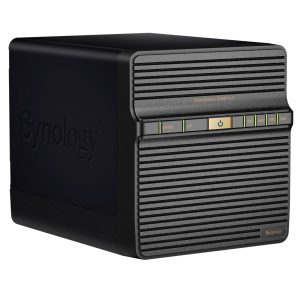Synology DS411 DiskStation RAID-5 Crash
RAID-5: Fault-Tolerant vs Failure-Proof
When you link up three or more drives using RAID-5, special parity data is spread across the drives. Thanks to the parity data, if any one hard drive in the array fails, the RAID controller can reconstruct all of the missing data. This is how RAID-5’s fault tolerance works. We elaborate further on the way RAID-5 and its parity data works on our RAID 5 data recovery page.
RAID-5 arrays crash when two or more hard drives fail. Parity data can only reconstruct the contents of one missing hard drive, and so if another hard drive fails, the user’s data becomes filled with holes. In theory, a RAID-5 array should almost never crash like this, because two drives will rarely fail at the exact same time. But unfortunately, that theory lacks a great deal of scientific rigor. The truth is that RAID-5 arrays do crash, and if the frequency of their appearance in our data recovery lab counts for anything, quite often.
Typically, one drive will fail, and when another drive fails, it does so months afterward. RAID-5 users are advised to replace failed drives immediately and begin rebuilding the array as soon as possible. But sometimes, the first drive’s failure goes entirely unnoticed. In other circumstances, the user replaces the drive and begins the process of integrating it into the array. But the rebuilding process puts additional stress on the other drives, which, ironically, can cause another hard drive failure! Sometimes, RAID-5 users will notice a drive failure and put off rebuilding for as long as possible due to this risk—and before they know it, it’s too late.
It’s important not to confuse fault-tolerance with failure-proofing. No data storage devices is perfectly failure-proof. Hence the need to make sure your most important files are backed up.
Is your failed Synology DS411 keeping you from your important data?

DiskStation DS411 Data Recovery
In this NAS data recovery case, the client had their Synology DiskStation DS411 sent to us after it failed to mount. The four-drive network attached storage device had its drive arranged in a RAID-5 configuration. Although RAID-5 provides fault tolerance, it lacks true failure immunity (as the client had learned, unfortunately, the hard way).
The client had been using their NAS device to back up their videos and family photos, and so, understandably, they needed those files back. It’s easy to lose sight of how much of our lives and memories we entrust to machines—and just how fragile those machines are. Nobody can predict when the device they store their data on might break down—whether it’s a single hard drive, a USB thumb drive, or a NAS enclosure with multiple hard drives. But when the unthinkable happens, Gillware Data Recovery is ready to help.

NAS Model: Synology DiskStation DS411+II 4-Bay NAS
RAID Level: RAID-5
Drive Model: Seagate Barracuda ST3000DM001
Total Capacity: 9 TB
Operating System: Linux Ext3
Situation: NAS became inaccessible and failed to mount; one stale drive
Type of Data Recovered: Videos and family photos
Binary Read: 99.9%
Gillware Data Recovery Case Rating: 9
Our cleanroom engineers took a look at the four drives from this RAID-5 NAS device. The Synology DiskStation had suffered two hard drive failures. One failure had occurred several months ago. This was the “stale” hard drive, because any data our engineers could salvage from it would be months out-of-date. Trying to rebuild the array with a stale hard drive would lead to widespread file corruption.
In RAID-5 data recovery situations, the most important hard drive to recover is the most recently failed drive. Because it was the last drive to fail, and its failure led to the entire array crashing, the data we can salvage from it is up-to-date with the data on the other healthy drives. The most recently failed drive had bad read/write heads, which needed to be replaced in our cleanroom data recovery lab.
After replacing the read/write heads in the failed hard drive, we were able to create a near-perfect disk image of the last failed drive. There had been minor damage to the drive’s platters due to its head crash. But only two thousand out of the trillions of sectors on the failed Seagate Barracuda hard drive were completely unreadable.
Once we had disk images of the drives in the array, they went over to our RAID recovery expert Cody. Drives in a RAID array have special metadata on them, which tell the RAID controller how they should fit together. Only the specific brand and model of RAID controller used to create the array knows how to parse the metadata. In order to link the drives up properly, our RAID experts must examine the metadata and create custom RAID controller emulation software to “trick” our disk images into linking together properly.
